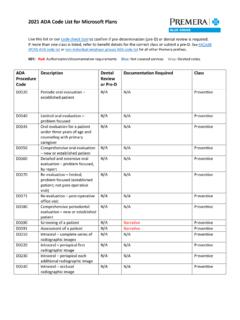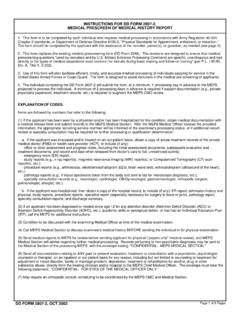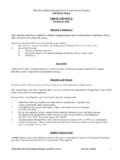Transcription of Cervical Cancer Screening Guidelines: What’s new?
1 Cervical Cancer Screening and Management Guidelines: Changing Again, Huh? Summary of 2013 recommendations from ASC (American Cancer Society), ASCCP (American Society for Colposcopy and Cervical pathology ), ASCCP (American Society for Clinical pathology ), USPTSF (US Preventive Task Force), and ACOG (American College of Obstetrics and Gynecology) and 2012-2013 updates Big problem!! Objectives Recognize the rationale for changing guidelines Use correct terminology for recommending Cervical Cancer Screening and discussing results Interpret results of Pap smear and formulate a follow up plan Utilize resources available in discussing Cervical Cancer Screening and follow up pap smear results Rationale for new changes To balance needed and unnecessary treatment High risk HPV necessary but not sufficient factor to develop CIN Smoking.
2 Compromised Immunity and +ve HIV increases persistence Persistent High risk HPV progresses to high grade lesion Persistence of high risk HPV for >2 yrs predicts subsequent CIN 3 or higher lesion Rationale for New changes HPV infection is most common in early 20 s In young healthy females with effective immune system HPV clears in 8-24 months High risk HPV prevalence decreases with age but risk of persistent infection increases with age. CIN1 is acute infection with high regression rate with recommended expectant management CIN3 has significant risk for progression, if untreated 30% at 30 yrs progress to invasive Cancer Talking about Screening pap smear Bad Method we look for the funny cells down there in your cervix Better Method this is a Screening test for the Cervical Cancer or abnormal cells in your cervix which if not detected or treated in timely manner can lead to Cervical Cancer which is totally preventable.
3 What is cervix? Terminology for pap results NIL- no cell lesions or malignancy noted ASCUS- atypical cells of undetermined significance LSIL- low grade squamous intraepithelial lesion ASC-H- changes in Cervical cells have been seen, cannot rule out HSIL HSIL- high grade intraepithelial lesion AGUS- atypical glandular cells of undetermined significance Usually endometrial biopsy done with this too AIS- adenocarcinoma in situ (a Cancer limited to the surface which has not invaded); rarest diagnosis CIN1-3- mild dysplasia to severe dysplasia Transformation zone absent, endometrial cells present, cellular atrophy Screening recommendations based on age/circumstance Healthy women ages 21-65 who have a cervix Pregnant women >65 years Post hysterectomy HIV positive Non HIV but Immunocompromised HPV vaccinated vs Unvaccinated Cytology Screening Recommendations No Cytology Screening before age 21 ( Gold Rule!)
4 ! ) Screen every three years from age 21 -29 Screen every 5 yrs from age 30-65 and include HPV testing Stop Screening at age 65 with appropriate previous Screening Abnormal Cytology Follow up New guidelines for pathology released in 2013 New category age 21-24 New language preferable and acceptable New Genotyping algorithm for women age >30 with a negative cytology but HPV positive. Healthy women 21- 24 yr No HPV testing recommended , if normal Pap rescreen every three yrs If unsatisfactory pap then repeat pap after 2-4 months - If Negative then routine testing - If abnormal- follow guidelines for abnormal cytology - if two unsatisfactory then proceed to colposcopy Negative but insufficient sample - Rescreen in three yrs Healthy women 21- 24 yr with ASCUS and LSIL ASCUS with Negative HPV screen every three yrs ASCUS with No HPV , positive HPV, or LSIL repeat Pap in 12 months -If pap negative, ASCUS or LSIL then repeat at 12 months -If at 12 months Pap HSIL, ASCH.
5 AGUS,AIS or CIS then colposcopy -If at 24 months pap is ASCUS,LSIL,HSIL,AGUS, AIS or CIS then coloposcopy *Gold rule is 2 times pap until unless high grade lesion, if high grade then colposcopy *If 2 consecutive negative PAP then proceed with three yr *Any abnormality at 24 months get the colposcopy Healthy women 21- 24 yr with HSIL Proceed to colposcopy If AGUS or AIS consider endometrial biopsy for high risk like family history, unexplained vaginal bleeding or chronci anovulation Knowledge testing 23 yr old female presents for pap smear, pap smear result comes back as LSIL , what would be recommendation A- Proceed to colposcopy B- Check for High risk HPV virus C- Repeat Pap smear in 12 months.
6 Repeat pap Smear in 12 months Knowledge testing 24 yr old female with previous history of ASCUS pap smear 12 month ago presents for pap sear, result comes back ASCUS again, what would you recommend? A- Proceed to colposcopy B- Check for High risk HPV virus C- Repeat Pap smear in 12 months Proceed to colposcopy Healthy Women ages 25-29 yr old If unsatisfactory pap and unknown HPV then repeat pap after 2-4 months - Abnormal- follow guidelines for abnormal cytology - Negative then routine testing - if two unsatisfactory then proceed to colposcopy Recommendation is to treat infection before repeating pap Negative but insufficient sample - Rescreen in three yrs Normal Pap - Rescreen in three yrs Healthy Women ages 25-29 yr old with ASCUS pap Smear ASCUS with
7 Negative HPV screen every three yrs ASUCS with positive HPV Proceed to colposcopy ASCUS with no HPV typing Repeat pap in 12 months - if pap negative at 12 months then Q3yr pap smear - if pap ASUCS,ASC_H,LSIL,HSIL,AGUS,AIS or CIS at 12 months then proceed to colposcopy. *Remember in this category (25-29 yr old )if repeat at 12 month is abnormal even if ASUCUS Proceed to colposcopy Healthy Women ages 25-29 yr old with LSIL or more severe pap Smear Proceed to colposcopy Knowledge Testing 27 yr old woman with history of ASCUS pap smear previous yr comes back for the pap smear and result comes back as ASCUS , what will be your follow up recommendation?
8 A- Check for high risk HPV B- Proceed to colposcopy C- Repeat pap smear in 12 months Proceed to colposcopy Healthy Women 30-65 management Pap and HPV co testing is the preferred method NIL with negative HPV- rescreen in 5 years ASCUS with negative HPV- rescreen in 3 years If unsatisfactory and negative HPV then repeat in 2-4months Negative pap with +ve HPV, either repeat in 12 months or test for high risk HPV LSIL with Negative HPV Cotesting in 12 months , if result ASUCUS or above or HPV positive then colposcopy ASCUS/LSIL with positive HPV- Colposcopy HSIL or more severe- Colposcopy *In this group preferred and acceptable language plays role * Persistent high risk HPV can lead to high risk changes Knowledge testing 35 yr old female comes back to discuss pap smear result which are ASCUS pap with negative HPV.
9 What follow up will be recommended? A- Repeat Pap in 12 months B- Repeat Pap Smear in three yrs C- Repeat Pap smear in five yrs D- Proceed to colposcopy Repeat Pap smear in Three yrs Women less than 21 years old Do not screen Incidence of Cervical Cancer has not changed despite 40 yrs of Screening If a woman was already screened: Result NIL- rescreen age 21 Result ASCUS, LSIL, or CIN1- rescreen every 12 months until 2 normal paps, then delay further Screening until age 21. If CIN1 persists, manage as appropriate Result ASC-H, HSIL, AGUS, AIS- colposcopy Women >65 No Cervical Cancer Screening recommended >65 years old if they have had prior adequate Screening (negative cytology alone or negative cytology and HPV as last pap smear) Even if a women has a new sexual partner after age 65, she does not need to be rescreened if above criteria are met Screening may be indicated in women >65 if they have never been screened (~50% of invasive Cervical Cancer cases are in women who have never been screened or haven t been screen in the past 5 years)
10 If woman has a hx of HSIL/CIN2, routine Screening should continue for 20 years every three yrs after regression or appropriate management of HSIL/CIN2 or higher lesions Pregnant women <21 years old, DON T SCREEN ASCCP practice committee states that age supersedes pregnancy Management is the same as 2006 guidelines NIL or ASCUS with neg HPV- rescreen at next appropriate interval ASCUS with pos HPV or LSIL: colposcopy either immediately or 6 weeks postpartum HSIL, ASC-H, AGUS, or AIS: colposcopy immediately Post hysterectomy with removal of cervix If no hx of HSIL or Cervical Cancer , Screening is not recommended No Screening recommended for women with hx of ovarian or endometrial Cancer and post hysterectomy HIV positive patient Should be screened twice within the first year after diagnosis of HIV If normal results, should screen annually ANY abnormal (ASCUS or higher) should get colposcopy HPV changes more common with HIV infection Pap produces more false NEGATIVES in the presence of HIV, which is why more frequent Screening is required (HRSA, 2005) What about WWE?








